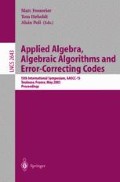Abstract
Public key cryptography was proposed in the 1976 seminal article of Diffie and Hellman [6]. One year later, Rivest, Shamir and Adleman introduced the RSA cryptosystem as a first example. From an epistemological perspective, one can say that Diffie and Hellman have drawn the most extreme consequence of a principle stated by Auguste Kerckhoffs in the XIXth century: “le mécanisme dè chiffrement doit pouvoir tomber sans inconvénient aux mains de l’ ennemi1”. Indeed, Diffie and Hellman understood that only the deciphering operation has to be controlled by a secret key: the enciphering method may perfectly be executed by means of a publicly available key, provided it is virtually impossible to infer the secret deciphering key from the public data.
The enciphering mechanism may fall into the enemy's hands without drawback
Access this chapter
Tax calculation will be finalised at checkout
Purchases are for personal use only
Preview
Unable to display preview. Download preview PDF.
References
M. Bellare, A. Desai, D. Pointcheval, and P. Rogaway. Relations among Notions of Security for Public-Key Encryption Schemes. In Crypto’ 98, LNCS 1462, pages 26–45. Springer-Verlag, Berlin, 1998.
M. Bellare and P. Rogaway. Random Oracles Are Practical: a Paradigm for Designing Efficient Protocols. In Proc. of the 1st CCS, pages 62–73. ACM Press, New York, 1993.
M. Bellare and P. Rogaway. Optimal Asymmetric Encryption — How to Encrypt with RSA. In Eurocrypt’ 94, LNCS 950, pages 92–111. Springer-Verlag, Berlin, 1995.
D. Bleichenbacher. A Chosen Ciphertext Attack against Protocols based on the RSA Encryption Standard PKCS #1. In Crypto’ 98, LNCS 1462, pages 1–12. Springer-Verlag, Berlin, 1998.
D. Coppersmith. Finding a Small Root of a Univariate Modular Equation. In Eurocrypt’ 96, LNCS 1070, pages 155–165. Springer-Verlag, Berlin, 1996.
W. Diffie and M.E. Hellman. New Directions in Cryptography, IEEE Transactions on Information Theory, v. IT-22, 6, Nov 1976, pages 644–654.
D. Dolev, C. Dwork, and M. Naor. Non-Malleable Cryptography. SIAM Journal on Computing, 30(2): 391–437, 2000.
E. Fujisaki, T. Okamoto, D. Pointcheval, and J. Stern. RSA-OAEP is Secure under the RSA Assumption. In Crypto’ 2001, LNCS 2139, pages 260–274. Springer-Verlag, Berlin, 2001.
S. Goldwasser and S. Micali. Probabilistic Encryption. Journal of Computer and System Sciences, 28: 270–299, 1984.
C. Hall, I. Goldberg, and B. Schneier. Reaction Attacks Against Several Public-Key Cryptosystems. In Proc. of ICICS’99, LNCS, pages 2–12. Springer-Verlag, 1999.
M. Naor and M. Yung. Public-Key Cryptosystems Provably Secure against Chosen Ciphertext Attacks. In Proc. of the 22nd STOC, pages 427–437. ACM Press, New York, 1990.
T. Okamoto and D. Pointcheval. REACT: Rapid Enhanced-security Asymmetric Cryptosystem Transform. In CT — RSA’ 2001, LNCS 2020, pages 159–175. Springer-Verlag, Berlin, 2001.
C. Rackoff and D. R. Simon. Non-Interactive Zero-Knowledge Proof of Knowledge and Chosen Ciphertext Attack. In Crypto’ 91, LNCS 576, pages 433–444. Springer-Verlag, Berlin, 1992.
R. Rivest, A. Shamir, and L. Adleman. A Method for Obtaining Digital Signatures and Public Key Cryptosystems. Communications of the ACM, 21(2):120–126, February 1978.
RSA Data Security, Inc. Public Key Cryptography Standards — PKCS. Available from http://www.rsa.com/rsalabs/pubs/PKCS/.
V. Shoup. OAEP Reconsidered. In Crypto’ 2001, LNCS 2139, pages 239–259. Springer-Verlag, Berlin, 2001.
Author information
Authors and Affiliations
Editor information
Editors and Affiliations
Rights and permissions
Copyright information
© 2003 Springer-Verlag Berlin Heidelberg
About this paper
Cite this paper
Stern, J. (2003). Cryptography and the Methodology of Provable Security. In: Fossorier, M., Høholdt, T., Poli, A. (eds) Applied Algebra, Algebraic Algorithms and Error-Correcting Codes. AAECC 2003. Lecture Notes in Computer Science, vol 2643. Springer, Berlin, Heidelberg. https://doi.org/10.1007/3-540-44828-4_1
Download citation
DOI: https://doi.org/10.1007/3-540-44828-4_1
Published:
Publisher Name: Springer, Berlin, Heidelberg
Print ISBN: 978-3-540-40111-7
Online ISBN: 978-3-540-44828-0
eBook Packages: Springer Book Archive

